Waltraud Wagner
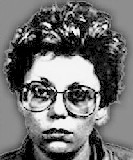
A.K.A.: "Lainz Angels of Death"
Classification: Serial killer
Characteristics: 'Death Angel' - Nurse - Poisoner
Number of victims: 15 +
Date of murder: 1983 - 1989
Date of arrest: April 7, 1989
Date of birth: 1960
Victim profile: Men and women (patients)
Method of murder: Poisoning (morphine overdose)
Location: Vienna, Austria
Status: Convicted of 15 murders, 17 attempts, and 2 counts of assault. Sentenced to life in prison in March 1991. Released in August 2008
Maria Gruber, Irene Leidolf, Stephanija Meyer, and Waltraud Wagner (Born 1960) made up one of the most unusual crime teams in 20th Century Europe. The four Austrian women were nurses working at Lainz General Hospital in Vienna, and together murdered scores of patients.
Wagner, 23, was the first to kill a patient with an overdose of morphine in 1983. She discovered in the process that she enjoyed playing God and holding the power of life and death in her hands. She recruited Gruber, 19, and Leidolf, 21, and eventually the "house mother" of the group, 43-year-old Stephanija Meyer.
However, lethal injection didn't provide enough excitement, and soon the self-styled "death pavilion" had invented their own murder method: while one held the victim's head and pinched their nose, another would pour water into the victim's mouth until they drowned in their bed. Since elderly patients frequently had fluid in their lungs, it was an unprovable crime.
They were caught after they were overheard bragging about their latest murder at a local tavern. In total, they confessed to 49 murders over six years, but may have been responsible for as many as 200.
Wagner was convicted of 15 murders, 17 attempts, and two counts of assault. She was sentenced to life in prison. Leidolf got life as well, on conviction of five murders, while the other two drew fifteen years for manslaughter and attempted murder charges.
Waltraud WAGNER, Maria GRUBER, Irene LEIDOLF y Stephanija MAYER
"Angels of Death"
Built in 1839, Lainz General Hospital is the fourth largest medical facility in Vienna, Austria, with some 2,000 persons on staff. Pavilion 5 at Lainz is typically reserved for problem cases --patients in their seventies or older, many of them terminally ill.
In such a setting, death is no surprise. If anything, it sometimes comes as a relief ... but there are limits, even so. Beginning in the spring of 1983 and lasting through the early weeks of 1989, Death got a helping hand at Lainz. Officially, the body count would stand at forty-two, but educated guesses put the final tally closer to 300 victims for the hospitals hard-working Angels of Death. Waltraud Wagner, a nurses aide on the graveyard shift at Pavilion 5, was twenty-four years old when she set the ball rolling in 1983.
As later reconstructed by authorities, she got the notion of eliminating patients when a 77-year-old woman asked Wagner to end her misery. Waltraud obliged the lady with a morphine overdose, discovering in the process that she enjoyed playing God, holding the power of life and death in her hands. It was too much fun to quit, too nice to keep from sharing with her special friends.
Over time, Wagner recruited three accomplices, all working the night shift at Pavilion 5. Maria Gruber, born in 1964, was a nursing school dropout and unwed mother. Irene Leidolf, two years older than Gruber, had a husband at home but preferred hanging out with the girls. Stephanija Mayer, a divorced grandmother twenty years Waltrauds senior, emigrated from Yugoslavia in 1987 and wound up at Lainz, soon joining ranks with her murderous cronies.
As described by prosecutors at her trial, Wagner was the sadistic Svengali of the group, instructing her disciples on the proper techniques of lethal injection, teaching them the water cure--wherein a patients nose was pinched, the tongue depressed, and water was poured down the throat. The victims death, while slow and agonizing, appeared natural on a ward where elderly patients frequently die with fluid in their lungs. In the police view, Wagner awakened their sadistic instincts.
Soon they were running a concentration camp, not a hospital ward. At the slightest sign of annoyance or complaint from a patient, theyd plan the patients murder for the following night. Annoyances, in Waltrauds book, included snoring, soiling the sheets, refusing medication, or buzzing the nurses station for help at inconvenient times. In such cases, Wagner would proclaim, This one gets a ticket to God, executing the murder herself or with help from one of her accomplices.
Even with four killers working the ward, it took some time for the deadly game to accelerate. Most of the homicides linked to Wagner and company occurred after early 1987, when Mayer rounded out the team, but Waltraud remained the prime mover and head executioner for what was soon nicknamed the death pavilion.
Rumors of a killer at large on Pavilion 5 were widespread by 1988, and Dr. Xavier Pesendorfer, in charge of the ward, was suspended in April 1989 for failure to launch a timely investigation. Still, it would be negligence among the killers that led to their ultimate downfall. Waltraud and her cohorts liked to have a few drinks after work, reliving special cases that amused them, chuckling over this victims dying expression or that ones convulsions.
In February 1989 they were giggling over the death of elderly Julia Drapal--treated to the water cure for refusing medication and calling Wagner a common slut--when a doctor seated nearby picked up snatches of the conversation. Horrified, he went to the police, and a six-week investigation led to the arrest of all four suspects on April 7.
In custody, the death angels confessed to forty-nine specific murders. Wagner allegedly claiming thirty-nine of her own. The ones who got on my nerves, she explained, were dispatched directly to a free bed with the good Lord. It was not always simple, she allowed: Of course the patients resisted, but we were stronger. We could decide whether these old fogies lived or died.
Their ticket to God was long overdue in any case. There was immediate speculation on a much higher body count, Wagners accomplices pointing guilty fingers at their mentor in a bid to save themselves. Alois Stacher, head of Viennas health department, quoted Irene Leidolf as being convinced that 100 patients were killed by Wagner in the past two years.
Stephanija Mayer admitted helping Wagner out on several homicides that Waltraud managed to forget. Indeed, as the case progressed to trial, Wagner became increasingly reluctant to discuss her role in the murders. By late 1990, she had backed off her original boast of thirty-nine victims, claiming a maximum of ten patients killed to ease their pain.
Chancellor Franz Vranitzky was unimpressed with the turn-about, calling the Lainz murder spree the most brutal and gruesome crime in Austrias history. Nor were judge and jury sympathetic when the four defendants went to trial in March of 1991.
Prosecutors failed to sell their case on forty-two counts of murder, but they proved enough to do the job. Waltraud Wagner was convicted of fifteen murders, seventeen attempted murders, and two counts of aggravated assault, drawing a sentence of life imprisonment.
Irene Leidolf also got life, on conviction of five murders and two bungled attempts. Stephanija Mayer earned fifteen years for a manslaughter conviction and seven counts of attempted murder, while Maria Gruber received an identical term for two murder attempts.
Angels of Death: The Female Nurses
A Sisterhood
Medical thriller writer Michael Palmer's first novel was The Sisterhood. It featured a group of nurses who start an underground organization to help people to die in hospitals around the country. "Nurses bound together in mercy," the jacket reads, "pledged to end human suffering." However, within the organization, some "mercy-killers" take things too far and patients who should have survived end up dead. What began as a benign act of compassion became a wellspring of evil.
This story is fiction. What follows is not.
It was a nurse's aide in Vienna, Austria, who started the murder spree at Lainz General Hospital. Most of the people who go there are elderly, many of them with terminal illnesses. It's not difficult to hide a murder or two among people who are already at death's door. Even so, it wasn't as if Waltraud Wagner wanted to kill… not at first, anyway.
It started in 1983 and by the time officials began to look into the suspicious deaths some six years later, the death toll stood at 42. However, an unofficial count was in the hundreds.
Wagner, 23, had a 77-year-old patient who one day asked the girl to "end her suffering." Wagner hesitatingly obliged by overdosing the woman with morphine. It was then that she discovered she enjoyed this kind of power, and it didn't take much to recruit accomplices from the night shift. Maria Gruber, 19, was happy to join. So was Ilene Leidolf, 21. The third recruit was a grandmother, 43-year-old Stephanija Mayer.
Wagner was the "death pavilion" leader, and they planned the murders as a group. She taught the others how to give lethal injections, and she added some fatal mechanisms of her own creation. The "water cure" involved holding a patient's nose while forcing him or her to drink. That was an agonizing death that filled the lungs, but undiscoverable as outright murder. Many elderly patients had fluid in their lungs.
Moving from compassion to sadism, the women took out patients who merely annoyed them by soiling sheets or asking for help too often. Such people were issued their "tickets to God."
At first, these nurses killed sporadically, but by 1987, they were escalating. Rumors began to spread that there was a killer on Pavilion Five.
It was their own carelessness that finally stopped them. Over drinks one day, they relived one of their latest cases, laughing over the patient's distress and the fact that she deserved her fate. At a table nearby sat a doctor. What he overheard sent him scurrying to the police station, and they quickly launched an investigation. It took six weeks, but all four women were arrested on April 7, 1989. The doctor in charge of their ward was suspended.
Collectively they confessed to 49 murders, and Wagner took credit for giving a "free bed with the good Lord" to 39 of them. She had decided that their deaths were long overdue, and she reveled in the fact that the power over their lives rested with her. However, one of her accomplices believed that Wagner's death count was closer to 200 in just the past two years.
As she sat in prison awaiting trial, Wagner scaled her culpability back to ten murders, all of them for reasons of mercy.
The jury didn't buy it. Ultimately, Wagner was convicted of 15 murders, 17 attempts, and two counts of assault. She was sentenced to life in prison. Leidolf got life as well, on conviction of five murders, while the other two drew 15 years for manslaughter and attempted murder charges.
As the state attorney put it, "It's a small step from killing the terminally ill to the killing of insolent, burdensome patients, and from there to that which was known under the Third Reich as euthanasia. It is a door that must never be opened again."
Austrians outraged over 'death angels' release
July 18, 2008
Two Austrian nurses nicknamed "death angels" after killing at least 20 elderly patients are to be released early from prison next month.
Waltraud Wagner, 49, and Irene Leidolf, 46, were convicted in 1991 of taking part in a seven-year killing spree at Vienna's Lainz hospital, between 1983 and 1989.
During their trial, prosecutors said the women had forced water into patients' lungs and injected them with large doses of insulin and tranquilisers, causing "terrible suffering".
Wagner and Leidof argued that their actions were mercy killings of old and chronically ill patients. Both were sentenced to life in prison.
However, the country's Justice Ministry today approved their conditional release on the grounds of good behaviour.
Two accomplices, Maria Gruber and Stefanija Mayer, were convicted as accessories on lesser charges of attempted murder and manslaughter. Both were released a few years ago and were issued with new identities as a precaution against vigilantes.
Officials refused to comment on whether Wagner and Leidolf would get new identities.
The four women initially admitted involvement in the deaths of up to 42 elderly patients, but police said they later retracted most of those confessions.
The imminent release of Wagner and Leidof has caused widespread outrage in Austria, with newspaper Heute leading with the headline "The death angels are getting out!".
The case has led some Austrians to question whether their sentencing system, in which the maximum life term usually means 15 years, is harsh enough.
Vienna bookkeeper Anna Rietsch said: "It's inhumane and immoral to execute a killer, but it's not fair to their victims' loved ones when a killer can look forward to a nice life outside prison."
Austria is still reeling from the scandal of Josef Fritzl's alleged 24-year imprisonment of a daughter prosecutors say he used as a sex slave.
Fritzl, a retired engineer, is expected to go on trial before the end of the year for allegedly holding his daughter Elisabeth captive in a windowless cell from the age of 18 and fathering seven children with her.
Fritzl could face a murder charge after it emerged one of the babies died and the body was allegedly tossed into a furnace.
In August 2006, Natascha Kampusch, then 18, escaped from the windowless cell where kidnapper Wolfgang Priklopil had confined her for eight-and-a-half years after abducting her as she walked to school..

Waltraud Wagner was convicted of fifteen murders, seventeen attempted murders,
and two counts of aggravated assault, drawing a sentence of life imprisonment.

Irene Leidolf also got life, on conviction of five murders and two bungled attempts.
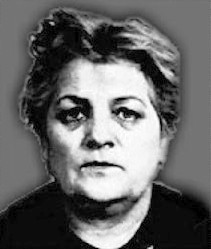
Stephanija Mayer earned fifteen years for a manslaughter conviction
and seven counts of attempted murder.
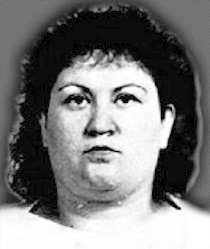
Maria Gruber was sentenced to fifteen years for two murder attempts.
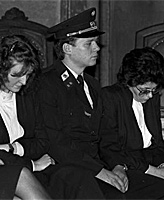
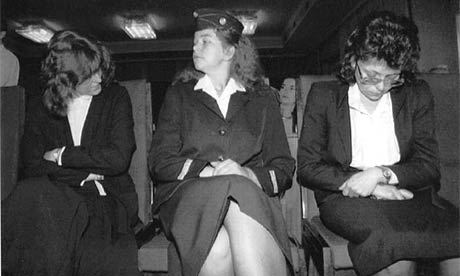
Irene Leidolf (l) and Waltraud Wagner (r) lower their heads before a court appeal in 1992.
(Photograph: Ronald Zak/AP)

Vienna's Lainz hospital.

A.K.A.: "Lainz Angels of Death"
Classification: Serial killer
Characteristics: 'Death Angel' - Nurse - Poisoner
Number of victims: 15 +
Date of murder: 1983 - 1989
Date of arrest: April 7, 1989
Date of birth: 1960
Victim profile: Men and women (patients)
Method of murder: Poisoning (morphine overdose)
Location: Vienna, Austria
Status: Convicted of 15 murders, 17 attempts, and 2 counts of assault. Sentenced to life in prison in March 1991. Released in August 2008
Maria Gruber, Irene Leidolf, Stephanija Meyer, and Waltraud Wagner (Born 1960) made up one of the most unusual crime teams in 20th Century Europe. The four Austrian women were nurses working at Lainz General Hospital in Vienna, and together murdered scores of patients.
Wagner, 23, was the first to kill a patient with an overdose of morphine in 1983. She discovered in the process that she enjoyed playing God and holding the power of life and death in her hands. She recruited Gruber, 19, and Leidolf, 21, and eventually the "house mother" of the group, 43-year-old Stephanija Meyer.
However, lethal injection didn't provide enough excitement, and soon the self-styled "death pavilion" had invented their own murder method: while one held the victim's head and pinched their nose, another would pour water into the victim's mouth until they drowned in their bed. Since elderly patients frequently had fluid in their lungs, it was an unprovable crime.
They were caught after they were overheard bragging about their latest murder at a local tavern. In total, they confessed to 49 murders over six years, but may have been responsible for as many as 200.
Wagner was convicted of 15 murders, 17 attempts, and two counts of assault. She was sentenced to life in prison. Leidolf got life as well, on conviction of five murders, while the other two drew fifteen years for manslaughter and attempted murder charges.
Waltraud WAGNER, Maria GRUBER, Irene LEIDOLF y Stephanija MAYER
"Angels of Death"
Built in 1839, Lainz General Hospital is the fourth largest medical facility in Vienna, Austria, with some 2,000 persons on staff. Pavilion 5 at Lainz is typically reserved for problem cases --patients in their seventies or older, many of them terminally ill.
In such a setting, death is no surprise. If anything, it sometimes comes as a relief ... but there are limits, even so. Beginning in the spring of 1983 and lasting through the early weeks of 1989, Death got a helping hand at Lainz. Officially, the body count would stand at forty-two, but educated guesses put the final tally closer to 300 victims for the hospitals hard-working Angels of Death. Waltraud Wagner, a nurses aide on the graveyard shift at Pavilion 5, was twenty-four years old when she set the ball rolling in 1983.
As later reconstructed by authorities, she got the notion of eliminating patients when a 77-year-old woman asked Wagner to end her misery. Waltraud obliged the lady with a morphine overdose, discovering in the process that she enjoyed playing God, holding the power of life and death in her hands. It was too much fun to quit, too nice to keep from sharing with her special friends.
Over time, Wagner recruited three accomplices, all working the night shift at Pavilion 5. Maria Gruber, born in 1964, was a nursing school dropout and unwed mother. Irene Leidolf, two years older than Gruber, had a husband at home but preferred hanging out with the girls. Stephanija Mayer, a divorced grandmother twenty years Waltrauds senior, emigrated from Yugoslavia in 1987 and wound up at Lainz, soon joining ranks with her murderous cronies.
As described by prosecutors at her trial, Wagner was the sadistic Svengali of the group, instructing her disciples on the proper techniques of lethal injection, teaching them the water cure--wherein a patients nose was pinched, the tongue depressed, and water was poured down the throat. The victims death, while slow and agonizing, appeared natural on a ward where elderly patients frequently die with fluid in their lungs. In the police view, Wagner awakened their sadistic instincts.
Soon they were running a concentration camp, not a hospital ward. At the slightest sign of annoyance or complaint from a patient, theyd plan the patients murder for the following night. Annoyances, in Waltrauds book, included snoring, soiling the sheets, refusing medication, or buzzing the nurses station for help at inconvenient times. In such cases, Wagner would proclaim, This one gets a ticket to God, executing the murder herself or with help from one of her accomplices.
Even with four killers working the ward, it took some time for the deadly game to accelerate. Most of the homicides linked to Wagner and company occurred after early 1987, when Mayer rounded out the team, but Waltraud remained the prime mover and head executioner for what was soon nicknamed the death pavilion.
Rumors of a killer at large on Pavilion 5 were widespread by 1988, and Dr. Xavier Pesendorfer, in charge of the ward, was suspended in April 1989 for failure to launch a timely investigation. Still, it would be negligence among the killers that led to their ultimate downfall. Waltraud and her cohorts liked to have a few drinks after work, reliving special cases that amused them, chuckling over this victims dying expression or that ones convulsions.
In February 1989 they were giggling over the death of elderly Julia Drapal--treated to the water cure for refusing medication and calling Wagner a common slut--when a doctor seated nearby picked up snatches of the conversation. Horrified, he went to the police, and a six-week investigation led to the arrest of all four suspects on April 7.
In custody, the death angels confessed to forty-nine specific murders. Wagner allegedly claiming thirty-nine of her own. The ones who got on my nerves, she explained, were dispatched directly to a free bed with the good Lord. It was not always simple, she allowed: Of course the patients resisted, but we were stronger. We could decide whether these old fogies lived or died.
Their ticket to God was long overdue in any case. There was immediate speculation on a much higher body count, Wagners accomplices pointing guilty fingers at their mentor in a bid to save themselves. Alois Stacher, head of Viennas health department, quoted Irene Leidolf as being convinced that 100 patients were killed by Wagner in the past two years.
Stephanija Mayer admitted helping Wagner out on several homicides that Waltraud managed to forget. Indeed, as the case progressed to trial, Wagner became increasingly reluctant to discuss her role in the murders. By late 1990, she had backed off her original boast of thirty-nine victims, claiming a maximum of ten patients killed to ease their pain.
Chancellor Franz Vranitzky was unimpressed with the turn-about, calling the Lainz murder spree the most brutal and gruesome crime in Austrias history. Nor were judge and jury sympathetic when the four defendants went to trial in March of 1991.
Prosecutors failed to sell their case on forty-two counts of murder, but they proved enough to do the job. Waltraud Wagner was convicted of fifteen murders, seventeen attempted murders, and two counts of aggravated assault, drawing a sentence of life imprisonment.
Irene Leidolf also got life, on conviction of five murders and two bungled attempts. Stephanija Mayer earned fifteen years for a manslaughter conviction and seven counts of attempted murder, while Maria Gruber received an identical term for two murder attempts.
Angels of Death: The Female Nurses
A Sisterhood
Medical thriller writer Michael Palmer's first novel was The Sisterhood. It featured a group of nurses who start an underground organization to help people to die in hospitals around the country. "Nurses bound together in mercy," the jacket reads, "pledged to end human suffering." However, within the organization, some "mercy-killers" take things too far and patients who should have survived end up dead. What began as a benign act of compassion became a wellspring of evil.
This story is fiction. What follows is not.
It was a nurse's aide in Vienna, Austria, who started the murder spree at Lainz General Hospital. Most of the people who go there are elderly, many of them with terminal illnesses. It's not difficult to hide a murder or two among people who are already at death's door. Even so, it wasn't as if Waltraud Wagner wanted to kill… not at first, anyway.
It started in 1983 and by the time officials began to look into the suspicious deaths some six years later, the death toll stood at 42. However, an unofficial count was in the hundreds.
Wagner, 23, had a 77-year-old patient who one day asked the girl to "end her suffering." Wagner hesitatingly obliged by overdosing the woman with morphine. It was then that she discovered she enjoyed this kind of power, and it didn't take much to recruit accomplices from the night shift. Maria Gruber, 19, was happy to join. So was Ilene Leidolf, 21. The third recruit was a grandmother, 43-year-old Stephanija Mayer.
Wagner was the "death pavilion" leader, and they planned the murders as a group. She taught the others how to give lethal injections, and she added some fatal mechanisms of her own creation. The "water cure" involved holding a patient's nose while forcing him or her to drink. That was an agonizing death that filled the lungs, but undiscoverable as outright murder. Many elderly patients had fluid in their lungs.
Moving from compassion to sadism, the women took out patients who merely annoyed them by soiling sheets or asking for help too often. Such people were issued their "tickets to God."
At first, these nurses killed sporadically, but by 1987, they were escalating. Rumors began to spread that there was a killer on Pavilion Five.
It was their own carelessness that finally stopped them. Over drinks one day, they relived one of their latest cases, laughing over the patient's distress and the fact that she deserved her fate. At a table nearby sat a doctor. What he overheard sent him scurrying to the police station, and they quickly launched an investigation. It took six weeks, but all four women were arrested on April 7, 1989. The doctor in charge of their ward was suspended.
Collectively they confessed to 49 murders, and Wagner took credit for giving a "free bed with the good Lord" to 39 of them. She had decided that their deaths were long overdue, and she reveled in the fact that the power over their lives rested with her. However, one of her accomplices believed that Wagner's death count was closer to 200 in just the past two years.
As she sat in prison awaiting trial, Wagner scaled her culpability back to ten murders, all of them for reasons of mercy.
The jury didn't buy it. Ultimately, Wagner was convicted of 15 murders, 17 attempts, and two counts of assault. She was sentenced to life in prison. Leidolf got life as well, on conviction of five murders, while the other two drew 15 years for manslaughter and attempted murder charges.
As the state attorney put it, "It's a small step from killing the terminally ill to the killing of insolent, burdensome patients, and from there to that which was known under the Third Reich as euthanasia. It is a door that must never be opened again."
Austrians outraged over 'death angels' release
July 18, 2008
Two Austrian nurses nicknamed "death angels" after killing at least 20 elderly patients are to be released early from prison next month.
Waltraud Wagner, 49, and Irene Leidolf, 46, were convicted in 1991 of taking part in a seven-year killing spree at Vienna's Lainz hospital, between 1983 and 1989.
During their trial, prosecutors said the women had forced water into patients' lungs and injected them with large doses of insulin and tranquilisers, causing "terrible suffering".
Wagner and Leidof argued that their actions were mercy killings of old and chronically ill patients. Both were sentenced to life in prison.
However, the country's Justice Ministry today approved their conditional release on the grounds of good behaviour.
Two accomplices, Maria Gruber and Stefanija Mayer, were convicted as accessories on lesser charges of attempted murder and manslaughter. Both were released a few years ago and were issued with new identities as a precaution against vigilantes.
Officials refused to comment on whether Wagner and Leidolf would get new identities.
The four women initially admitted involvement in the deaths of up to 42 elderly patients, but police said they later retracted most of those confessions.
The imminent release of Wagner and Leidof has caused widespread outrage in Austria, with newspaper Heute leading with the headline "The death angels are getting out!".
The case has led some Austrians to question whether their sentencing system, in which the maximum life term usually means 15 years, is harsh enough.
Vienna bookkeeper Anna Rietsch said: "It's inhumane and immoral to execute a killer, but it's not fair to their victims' loved ones when a killer can look forward to a nice life outside prison."
Austria is still reeling from the scandal of Josef Fritzl's alleged 24-year imprisonment of a daughter prosecutors say he used as a sex slave.
Fritzl, a retired engineer, is expected to go on trial before the end of the year for allegedly holding his daughter Elisabeth captive in a windowless cell from the age of 18 and fathering seven children with her.
Fritzl could face a murder charge after it emerged one of the babies died and the body was allegedly tossed into a furnace.
In August 2006, Natascha Kampusch, then 18, escaped from the windowless cell where kidnapper Wolfgang Priklopil had confined her for eight-and-a-half years after abducting her as she walked to school..

Waltraud Wagner was convicted of fifteen murders, seventeen attempted murders,
and two counts of aggravated assault, drawing a sentence of life imprisonment.

Irene Leidolf also got life, on conviction of five murders and two bungled attempts.

Stephanija Mayer earned fifteen years for a manslaughter conviction
and seven counts of attempted murder.

Maria Gruber was sentenced to fifteen years for two murder attempts.


Irene Leidolf (l) and Waltraud Wagner (r) lower their heads before a court appeal in 1992.
(Photograph: Ronald Zak/AP)

Vienna's Lainz hospital.


